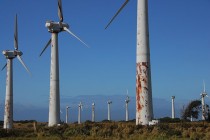Current scientific knowledge does not substantiate Ban Ki-Moon assertions on weather and climate, say 125 scientists

UN Secretary-General Ban Ki-Moon
Policy actions that aim to reduce CO2 emissions are unlikely to influence future climate. Policies need to focus on preparation for, and adaptation to, all dangerous climatic events, however caused
Open Letter to the Secretary-General of the United Nations
H.E. Ban Ki-Moon, Secretary-General, United Nations
First Avenue and East 44th Street, New York, New York, U.S.A.
November 29, 2012
Mr. Secretary-General:
On November 9 this year you told the General Assembly: “Extreme weather due to climate change is the new normal...Our challenge remains, clear and urgent: to reduce greenhouse gas emissions, to strengthen adaptation to even larger climate shocks and to reach a legally binding climate agreement by 2015… This should be one of the main lessons of Hurricane Sandy.”
On November 13 you said at Yale: “The science is clear; we should waste no more time on that debate.”
The following day, in Al Gore’s “Dirty Weather” Webcast, you spoke of “more severe storms, harsher droughts, greater floods”, concluding: “Two weeks ago, Hurricane Sandy struck the eastern seaboard of the United States. A nation saw the reality of climate change. The recovery will cost tens of billions of dollars. The cost of inaction will be even higher. We must reduce our dependence on carbon emissions.”
We the undersigned, qualified in climate-related matters, wish to state that current scientific knowledge does not substantiate your assertions.
The U.K. Met Office recently released data showing that there has been no statistically significant global warming for almost 16 years. During this period, according to the U.S. National Oceanic and Atmospheric Administration (NOAA), carbon dioxide (CO2) concentrations rose by nearly 9% to now constitute 0.039% of the atmosphere. Global warming that has not occurred cannot have caused the extreme weather of the past few years. Whether, when and how atmospheric warming will resume is unknown. The science is unclear. Some scientists point out that near-term natural cooling, linked to variations in solar output, is also a distinct possibility.
The “even larger climate shocks” you have mentioned would be worse if the world cooled than if it warmed. Climate changes naturally all the time, sometimes dramatically. The hypothesis that our emissions of CO2 have caused, or will cause, dangerous warming is not supported by the evidence.
The incidence and severity of extreme weather has not increased. There is little evidence that dangerous weather-related events will occur more often in the future. The U.N.’s own Intergovernmental Panel on Climate Change says in its Special Report on Extreme Weather (2012) that there is “an absence of an attributable climate change signal” in trends in extreme weather losses to date. The funds currently dedicated to trying to stop extreme weather should therefore be diverted to strengthening our infrastructure so as to be able to withstand these inevitable, natural events, and to helping communities rebuild after natural catastrophes such as tropical storm Sandy.
There is no sound reason for the costly, restrictive public policy decisions proposed at the U.N. climate conference in Qatar. Rigorous analysis of unbiased observational data does not support the projections of future global warming predicted by computer models now proven to exaggerate warming and its effects.
The NOAA “State of the Climate in 2008” report asserted that 15 years or more without any statistically-significant warming would indicate a discrepancy between observation and prediction. Sixteen years without warming have therefore now proven that the models are wrong by their creators’ own criterion.
Based upon these considerations, we ask that you desist from exploiting the misery of the families of those who lost their lives or properties in tropical storm Sandy by making unsupportable claims that human influences caused that storm. They did not. We also ask that you acknowledge that policy actions by the U.N., or by the signatory nations to the UNFCCC, that aim to reduce CO2 emissions are unlikely to exercise any significant influence on future climate. Climate policies therefore need to focus on preparation for, and adaptation to, all dangerous climatic events however caused.
Signed by over 125 international scientists - see list here
------------
As part of the 24 hour of programming designed to counter Al Gore’s Dirty Weather 24 hour of programming, I was able to do two segments, the first on extreme weather and the second on Sandy. My apologies on the second presentation in which at the end I did an imitation of Andrea Bocelli. I thought I was doing a voice over graphics still at that point. My bad. I often close my eyes when doing radio to avoid distractions. Close your eye and just listen.
Our energy and environment deserve better in South Africa and Qatar
By Kelvin Kemm
A few weeks ago, perhaps as a prologue to the “global warming disaster” convention in Doha, Qatar, South Africa’s Department of Environment Affairs took out a full-page advertisement in our country’s newspapers, promoting National Marine Week.
The ad showed a map of the Antarctic continent, from above the pole, surrounded by the vast blue Southern Ocean. It also promoted South Africa’s new Antarctic research vessel, SA Agulhas II.
The advertisement’s text mentioned the massive Antarctic Circumpolar Current, which is responsible for distributing vital nutrients to the world’s oceans. It noted that the truly massive quantities of phytoplankton found in the ocean are vital marine building blocks in ocean processes. All that is true, and I certainly applaud efforts to protect the environment and promote National Marine Week and our country’s research efforts.
But then, sadly, the ad’s discussion of physics content went off the rails. Referring to phytoplankton, it said “these microscopic creatures also use carbon to create energy.” Wrong!
The most basic law of thermodynamics says energy is neither created nor destroyed, but merely converted from one form to another. The only way to “create” energy is via a nuclear process, whereby matter is converted to energy in a nuclear reaction, as Einstein famously postulated over a century ago. Nuclear processes operate outside the laws of thermodynamics, but there is certainly no nuclear process going on in phytoplankton.
I could have lived with that slip up in the physics. But it got worse - much worse. The ad went on to blame global warming for upsetting the phytoplankton. In a declaration straight out of Alice in Wonderland, it asserted: “The increase in surface temperature over Antarctica from climate change is having a catastrophic knock-on effect, depleting phytoplankton stocks, melting the Antarctic ice sheet and causing an alarming reduction in all marine life.”
First, to the best of my knowledge, there has been no “alarming reduction in all marine life.” None of my colleagues are aware of it. Second, the surface temperature over Antarctica is not increasing.
In fact, a new record has just been attained. Antarctic sea ice has just reached an all-time record for total acreage. Day 265 of the year 2012 set an all time record, and then on day 266 that record was broken. The days 265 to 270 were the six highest Antarctic sea ice extent days of all time.
The environment department then compounded these errors by committing the unforgivable scientific sin of claiming a supposed increase in surface air temperature over Antarctica “is having a catastrophic knock-on effect” then providing no evidence to back up its assertion and not telling readers what the alleged knockon effect is.
I cannot even begin to imagine how this knockon is supposed to alter the Circumpolar Current, which in turn is somehow supposed to affect the “energy creation” capabilities of phytoplankton. Come off it, folks.
There is so much good Antarctic science to be proud of and, for that matter, really fine South African scientific achievements in the Antarctic to brag about. That the DEA would feel compelled to celebrate National Maritime Week by resorting to phytoplankton scares supposedly related to nonexistent Antarctic heating is beyond mystifying.
Meanwhile, over the last few months, newspaper stories have told of reduced sea ice extent at our planetís other pole, the Arctic. Terms like “alarming rate” of ice depletion were bandied about casually. Yes, there were reductions in Arctic sea ice cover.
However, on September 18, a video posted by NASA on its website showed that a large and long lasting Arctic cyclone “wreaked havoc on the Arctic sea ice cover,” by “breaking up sea ice.” The unusual reduction in Arctic sea ice cover was due to high winds not to any warming of the Arctic or global warming in general. NASA’s belated analysis demonstrated that a large section of ice north of the Chukchi Sea was cut off by the churning storm, broken up and pushed south into warmer waters, where it melted.
The storm also broke up other ice, accelerating drifting and melting elsewhere. Reuters finally reported that “NASA says a powerful cyclone formed off the coast of Alaska in early August and moved toward the centre of the Arctic Ocean, weakening the already thin sea ice as it went.”
NASA noted that this was an “uncommon event” and that there have been only about eight storms of similar strength during August in 34 years of satellite records. However, a major storm every four years is not all that “uncommon.” Paul A. Newman, Chief Scientist for Atmospheric Sciences at NASA’s Goddard Space Flight Centre, added that such wind disturbances produce many effects and can also lift warmer water from the depths of the Arctic Ocean up to the surface to accelerate melting.
For some reason probably having to do with its regular promotion of “dangerous manmade global warming” claims - the storm story was barely mentioned in the mainstream popular media. By contrast, the “alarming ice cover reduction” narrative was covered extensively.
Now jump back in time five years, to December 12, 2007. On that date Associated Press writer Seth Borenstein distributed an article that stated: “An already relentless melting of the Arctic greatly accelerated this summer a sign that some scientists worry could mean global warming has passed an ominous tipping point. One scientist even speculated that summer sea ice could be gone in five years.”
Well, five years have come and gone. Borenstein was dead wrong. Does anyone suppose the AP will now publish an apology, admitting that its “science writer” was on thin ice when he made this outlandish statement, and saying he should not have tried to scare the public like that?
Perhaps the answer can be found in Lewis Carroll’s Alice in Wonderland.
“There’s no use trying,” Alice said. “One can’t believe impossible things.” “I daresay you haven’t had much practice,” said the Queen. “When I was younger, I always did it for half an hour a day. Why, sometimes I’ve believed as many as six impossible things before breakfast.”

Especially with the Doha climate change confab in full swing, taxpayers, newspaper readers and anyone dreaming of a better life through reliable, affordable energy deserves more honest reporting and more science-based energy and environmental policies than they have been getting.
__________
Dr Kelvin Kemm is a nuclear physicist and business strategy consultant in Pretoria, South Africa. He is a member of the International Board of Advisors of the Committee For A Constructive Tomorrow (CFACT), based in Washington, DC (www.CFACT.org). Dr. Kemm received the prestigious Lifetime Achievers Award of the National Science and Technology Forum of South Africa.
-----------
By Steve Goreham

Photo: Abandoned Wind Farms Hawaii tonyaardvark.com
CHICAGO, November 26, 2012 - The U.S. wind industry is in despair. The Production Tax Credit (PTC), a subsidy of 2.2 cents per kilowatt hour to producers of electricity from wind turbines, is set to expire at the end of this year. The American Wind Energy Association cites a study by Navigant Consulting, claiming that, “...37,000 Americans stand to lose their jobs by the end of the first quarter of 2013 if Congress does not extend the PTC.”
The Natural Resources Defense Council, the Sierra Club, and other environmental groups have rushed to the defense of the PTC. The Sierra Club states, “At a time when we need clean energy more than ever, we simply cannot afford to let the PTC expire.” The PTC is the cornerstone of President Obama’s green energy program and a key measure supported by environmental efforts to fight global warming.
The Production Tax Credit was established by the Energy Policy Act of 1992 to support the nascent wind industry. But twenty years later, is this subsidy still needed? By the end of 2011, 39,000 wind turbine towers were operating in the United States and about 185,000 turbines were in operation worldwide, according to the International Energy Agency. This is no longer an infant industry. Despite the large number of wind towers, wind provides less than one percent of U.S. energy and less than one percent of global energy. A one-year extension of the PTC would cost American taxpayers over $12 billion.
In September, 19 companies sent a letter to the leaders of the U.S. House of Representatives, urging extension of the PTC. Why would Johnson & Johnson, Sprint, Starbucks, and other signers of the letter support subsidies for another industry? They voiced concern that “Failure to extend the PTC for wind would tax our companies and thousands of others like us that purchase significant amounts of renewable energy...”
Never has corporate America been so misguided. Foolish policies like the PTC and proactive company programs to buy “green” renewable energy are based on Climatism, the belief that man-made greenhouse gases are destroying Earth’s climate. An increasing body of science shows that climate change is natural and that human emissions are insignificant. Nevertheless, Johnson & Johnson’s web site claims a reduction of 23 percent in carbon dioxide emissions from 1990‒2010. That emissions reduction and two bucks might get you a cup of Starbuck’s coffee.
While many people would like to power the world with zephyrs, the intermittency of the wind means that wind turbines cannot replace conventional nuclear, natural gas, or coal power plants. The 39,000 U.S. wind turbines generated only 29% of their rated output during 2011. When the wind doesn’t blow, conventional power plants must provide backup power if continuity of electrical supply is to be maintained.
In fact, electricity sourced from wind turbines does not cut CO2 emissions from a power system. Because of the rapid variation in the wind, backup coal or natural gas power plants must frequently and inefficiently cycle on and off to support demand. Studies from electrical power systems in Netherlands, Colorado, and Texas show that combined wind-conventional systems emit more CO2 and use more fuel than conventional systems alone.
Wind is also more costly than conventional systems. Analysis from the U.S. Department of Energy (DOE) shows that electricity from both coal and natural gas is much less expensive than from wind power, without requiring subsidies for operation. The DOE estimates the world has 200 years of technically recoverable reserves of natural gas, thanks to the hydraulic fracturing revolution. If the theory of man-made global warming is wrong, why subsidize another wind turbine?
The government can always provide subsidies to create jobs or to sustain jobs, but this may not be the best public policy. Thomas Jefferson was correct when he said, “It is error alone which requires the support of government. Truth can stand by itself.” Suppose we let the wind industry compete on its own merit?
Steve Goreham is Executive Director of the Climate Science Coalition of America and author of the new book The Mad, Mad, Mad World of Climatism: Mankind and Climate Change Mania.
Reprinted with this request from author:
Please consider to post the article at the link below (and enclosed) on Icecap. The article questions the value of extending the expiring Production Tax Credit for wind energy. If you do post, please provide a link to the original article at The Washington Times.



